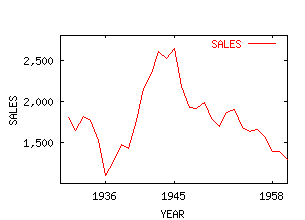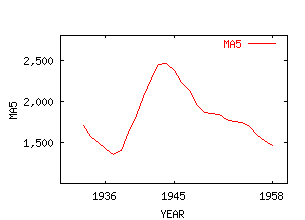Moving Averages and Exponential Smoothing
The SMOOTH command provides features
for smoothing data by methods of moving averages and
exponential smoothing.
Consider a time series with observed values X1, X2, ..., XN. A centered 5-point moving average is obtained as:
 for
t = 3, ..., N
for
t = 3, ..., N-2
The number of periods used in calculating the moving average is
specified with the NMA= option on the
SMOOTH command.
The simple exponential smoothing method is based on a weighted average of current and past observations, with most weight to the current observation and declining weights to past observations. This gives the formula for the smoothed series as:

where w is a smoothing constant with a value in the range [0,1].
The value for w is specified with the WEIGHT=
option on the SMOOTH command.
Example
This example analyzes annual sales data (in thousands of dollars) of
Lydia E. Pinkham from 1931 to 1960. The data set is listed in
Newbold [1995, p. 691].
The SHAZAM commands (filename:
MASMOOTH.SHA) below
use the SMOOTH command to calculate
a centered 5-point moving average and a series smoothed by
exponential smoothing.
SAMPLE 1 30 READ SALES / BYVAR 1806 1644 1814 1770 1518 1103 1266 1473 1423 1767 2161 2336 2602 2518 2637 2177 1920 1910 1984 1787 1689 1866 1896 1684 1633 1657 1569 1390 1387 1289 GENR YEAR=TIME(1930) * Set the smoothing constant for exponential smoothing. GEN1 A=0.4 GEN1 W=1-A SMOOTH SALES / NMA=5 WEIGHT=W MAVE=MA5 * Graph the original data GRAPH SALES YEAR / LINEONLY * Graph the smoothed series SAMPLE 3 28 GRAPH MA5 YEAR / LINEONLY STOP |
The SHAZAM output can be viewed.
The results for a centered 5-point moving average are listed on the
SHAZAM output in the column MOVING-AVE
(see Newbold [1995, Table 17.12, p. 698]).
The results from exponential smoothing are listed in the column
EXP-MOV-AVE (see Newbold [1995, Table 17.16, p. 710]).
In the above SHAZAM commands, the MAVE= option
on the SMOOTH command is used to save the
moving average in the variable MA5. The
GRAPH command is then used to graph the results.
A graph of the sales data is shown below (see Newbold [1995, Figure 17.6, p. 695]).

The next graph shows the series smoothed by moving averages (see Newbold [1995, Figure 17.7, p. 698]).

Forecasting with Exponential Smoothing
Exponential smoothing methods use recursive updating formula to generate forecasts. A comparison of these methods with ARIMA models is given in Mills [1990, pp. 153-163]. The recursive formula required by exponential smoothing methods can be programmed in SHAZAM. This is shown with examples from Newbold [1995, Chapter 17].
- Simple Exponential Smoothing - for nonseasonal series with no trend
- Holt-Winters Exponential Smoothing - for nonseasonal series with trend
References
Terence C. Mills, Time Series Techniques for Economists, 1990, Cambridge University Press.
Paul Newbold, Statistics for Business & Economics, Fourth Edition, 1995, Prentice-Hall.
 [SHAZAM Guide home]
[SHAZAM Guide home]
SHAZAM output - Moving Averages and Simple Exponential Smoothing
|_SAMPLE 1 30
|_READ SALES / BYVAR
1 VARIABLES AND 30 OBSERVATIONS STARTING AT OBS 1
|_GENR YEAR=TIME(1930)
|_* Set the smoothing constant for exponential smoothing.
|_GEN1 A=0.4
|_GEN1 W=1-A
|_SMOOTH SALES / NMA=5 WEIGHT=W MAVE=MA5
CENTRAL MOVING AVERAGES - PERIODS= 5 NSPAN= 1 WEIGHT= 0.600
OBSERVATION SALES MOVING-AVE SEAS&IRREG SA(SALES ) EXP-MOV-AVE
1 1806.0 ------- ------- 1806.0 1806.0
2 1644.0 ------- ------- 1644.0 1708.8
3 1814.0 1710.4 1.0606 1814.0 1771.9
4 1770.0 1569.8 1.1275 1770.0 1770.8
5 1518.0 1494.2 1.0159 1518.0 1619.1
6 1103.0 1426.0 0.77349 1103.0 1309.4
7 1266.0 1356.6 0.93322 1266.0 1283.4
8 1473.0 1406.4 1.0474 1473.0 1397.2
9 1423.0 1618.0 0.87948 1423.0 1412.7
10 1767.0 1832.0 0.96452 1767.0 1625.3
11 2161.0 2057.8 1.0502 2161.0 1946.7
12 2336.0 2276.8 1.0260 2336.0 2180.3
13 2602.0 2450.8 1.0617 2602.0 2433.3
14 2518.0 2454.0 1.0261 2518.0 2484.1
15 2637.0 2370.8 1.1123 2637.0 2575.9
16 2177.0 2232.4 0.97518 2177.0 2336.5
17 1920.0 2125.6 0.90327 1920.0 2086.6
18 1910.0 1955.6 0.97668 1910.0 1980.6
19 1984.0 1858.0 1.0678 1984.0 1982.7
20 1787.0 1847.2 0.96741 1787.0 1865.3
21 1689.0 1844.4 0.91574 1689.0 1759.5
22 1866.0 1784.4 1.0457 1866.0 1823.4
23 1896.0 1753.6 1.0812 1896.0 1867.0
24 1684.0 1747.2 0.96383 1684.0 1757.2
25 1633.0 1687.8 0.96753 1633.0 1682.7
26 1657.0 1586.6 1.0444 1657.0 1667.3
27 1569.0 1527.2 1.0274 1569.0 1608.3
28 1390.0 1458.4 0.95310 1390.0 1477.3
29 1387.0 ------- ------- 1387.0 1423.1
30 1289.0 ------- ------- 1289.0 1342.7
1 SEASONAL FACTORS
1 1.0000
|_* Graph the original data
|_GRAPH SALES YEAR / LINEONLY
30 OBSERVATIONS
SHAZAM WILL NOW MAKE A PLOT FOR YOU
NO SYMBOLS WILL BE PLOTTED, LINE ONLY
|_* Graph the smoothed series
|_SAMPLE 3 28
|_GRAPH MA5 YEAR / LINEONLY
26 OBSERVATIONS
SHAZAM WILL NOW MAKE A PLOT FOR YOU
NO SYMBOLS WILL BE PLOTTED, LINE ONLY
|_STOP
 [SHAZAM Guide home]
[SHAZAM Guide home]